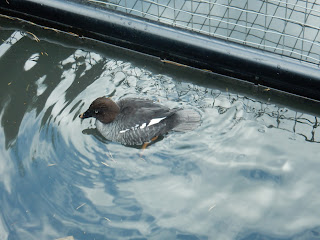The wetland centre is, in large part, intended to be a reserve for wildlife, and during the
A tufted duck photobombing.
The wetland centre's bat house.
There are a large number of non-native rose-ringed parakeets at the wetland centre (and reportedly elsewhere in London).
Though the place is teeming with wildlife, much of it can only be seen at great distances. This is the best picture I was able to get of a northern lapwing (with another photobombing tufted duck).
I had better luck photographing their captive waterfowl. The wetland centre almost certainly has more species of captive waterfowl than anywhere else I've been to, many of them rarely seen. Here are (from left to right) some emperor geese, red-breasted geese, barnacle geese, and brant.
More of the above (along with a wild Eurasian moorhen).
A goose nest from one of the above species out in the open. (I don't know which.) I am curious as to whether the captives here are ever threatened by local predators. Peregrine falcons have been sighted at the wetland centre; I wonder whether they're ever in the mood for something exotic. (The geese are likely relatively safe from falcons, but the smaller duck species would have at least the potential to be preyed upon.)
A couple of Bewick's swans (sometimes considered a subspecies of tundra swan).
The species kept here are arranged geographically. Here is a female common goldeneye.
Some of her pondmates, more goldeneyes and smews (and wild moorhens and mallards), representing a Eurasian setting.
The next pond over had canvasbacks, wood ducks, hooded mergansers, and buffleheads, species I am familiar with as a North American birder. (There are also some freeloading black-headed gulls and mallards in this photo.) Many of these species nest in tree cavities; I wonder how that works (as I assume it does) here at the wetland centre considering the ducks presumably have their wings clipped.
A white-headed duck, known from the Middle East, central Asia, and northern Africa.
It repeatedly reared up vertically on the water surface. This looked like some form of display, but I am not familiar with this behavior. Anyone know better?
Next up were the South American marshes, featuring these crested screamers. Despite appearances, they are also waterfowl. They grow daggers on their wings.
Looking much more like a typical duck, a puna teal.
Puna teal again, with ringed teal in the background.
Jumping abruptly to the Arctic, common eiders, with greater scaup and northern pintails (mostly in the background).
Right across from them, we return to the Southern Hemisphere with this Australian magpie goose.
A pair of radjah shelducks.
The London Wetland Centre is involved in captive breeding and reintroduction efforts for endangered waterfowl, such as these Hawaiian Laysan ducks.
The state bird of Hawaii, the nene.
Endangered white-winged ducks from tropical Asia.
Among the few non-waterfowl species housed here are these white-naped cranes. This exhibit is meant to represent an Asian rice paddy.
A falcated duck and a spot-billed duck (foreground).
An unmistakable Baikal teal.
The various bird feeders at the wetland centre were well attended. Here a blue tit and a great tit pay a visit to one, as they frequently do.
A brown rat partaking in scraps from the feeder.
The two-storey observatory is set up to resemble an airport for birds, which is clever.













































































